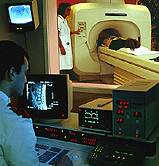
TUESDAY, Feb. 5 (HealthDay News) — The potential cancer risk that younger adults face from exposure to CT scans pales in comparison to the actual threat posed by health conditions driving the use of the imaging technology, a new study indicates.
Examining medical records from about 22,000 patients between the ages of 18 and 35 who underwent CT scans on their chest, abdomen or pelvis, scientists determined that patients were far more likely to die from conditions prompting the scan — such as trauma, abdominal pain or difficulty breathing — than to develop a fatal cancer because of radiation from the scan itself.
“We realized that these people were coming in with very serious medical problems … and a lot of them were really sick, but not dying from cancer,” said study author Dr. Susanna Lee, chief of women’s imaging at Massachusetts General Hospital and an assistant professor of radiology at Harvard Medical School in Boston.
“From a radiologist’s point of view, this actually helps me have a more informed discussion with my patients when we’re talking about the risks and benefits of getting a scan,” Lee added. “It gives me a better assessment as far as explaining what they’re up against. It favors getting more information.”
The study was published online Feb. 5 in the journal Radiology.
The rate of CT use has increased about 10 percent annually over the past 15 years, according to the study, and nearly 80 million CT scans were done in the United States alone in 2010. Computer models have estimated that up to 2 percent of cancers in the United States can be attributed to CT scanning.
The patients analyzed underwent a cumulative 41,000 scans of the chest, abdomen or pelvis between 2003 and 2007. Followed for an average of five and a half years, about 7 percent and 4 percent of those having chest and abdominopelvic CT scans, respectively, died in that time period.
Those figures were much higher than the 0.1 percent long-term mortality risk from radiation-induced cancer for both groups, Lee said, and also far higher than the 1 percent chance of death an average young adult faces over a five-year period.
Lee said she didn’t know if the results would be applicable to older adults, since younger people are more vulnerable to ionizing radiation in CT scans and more likely to live for the 10 to 20 years considered necessary to develop a radiation-induced cancer.
But even in the past five years — since the end of the study period — radiation doses from CT scans have dropped, thanks to newer technology and better attention to medical protocols, Lee noted. Also, patients scanned only once or twice, compared with cancer patients, for example, who might undergo many CT scans over the course of treatment, represented the vast majority of those studied.
“People’s perception of risk can get so skewed if they don’t see the bigger picture,” Lee said. “If you have a 20-year-old with lymphoma … you need to make sure they’re getting cured of the lymphoma first, and if scans are providing additional information for the doctor and them, they need to put that in the bigger picture.”
Although the new research seemed to outline the risks and benefits of CT scans for the younger population, one radiology expert criticized the study’s methodology.
“The method the authors used to determine that the imaging benefits outweighed the harm was overly simplistic, and I do not believe in any way contributes to the need to understand how to improve the use of imaging,” said Dr. Rebecca Smith-Bindman, a professor of radiology and biomedical imaging epidemiology and biostatistics at the University of California, San Francisco.
More information
The U.S. National Cancer Institute offers more on CT scans.

